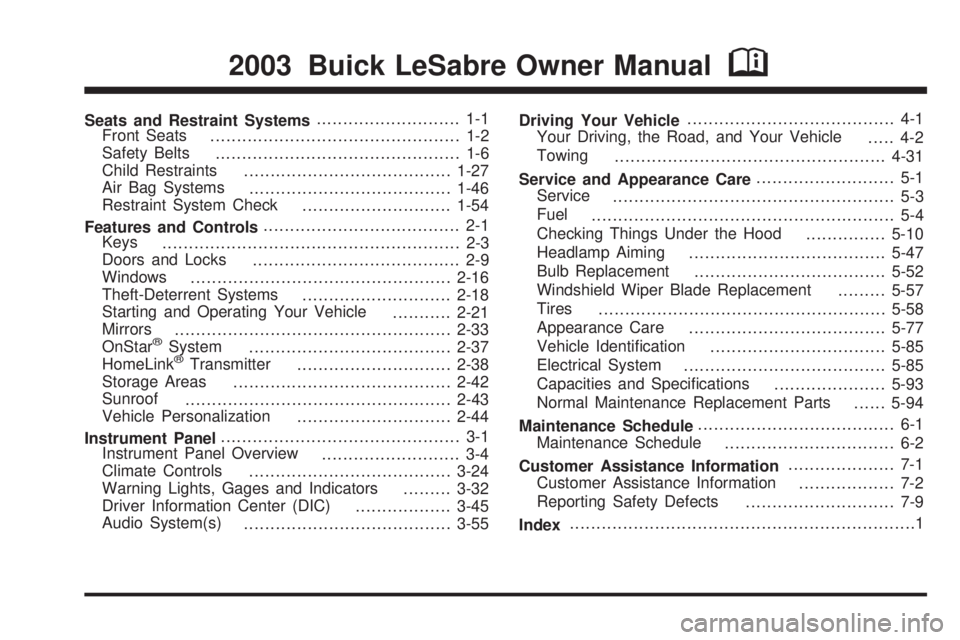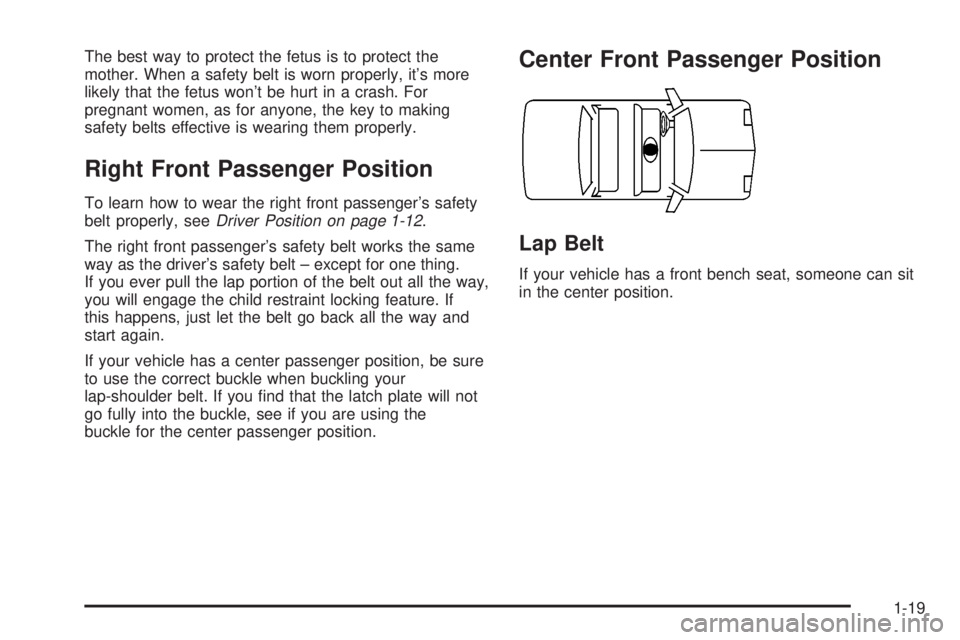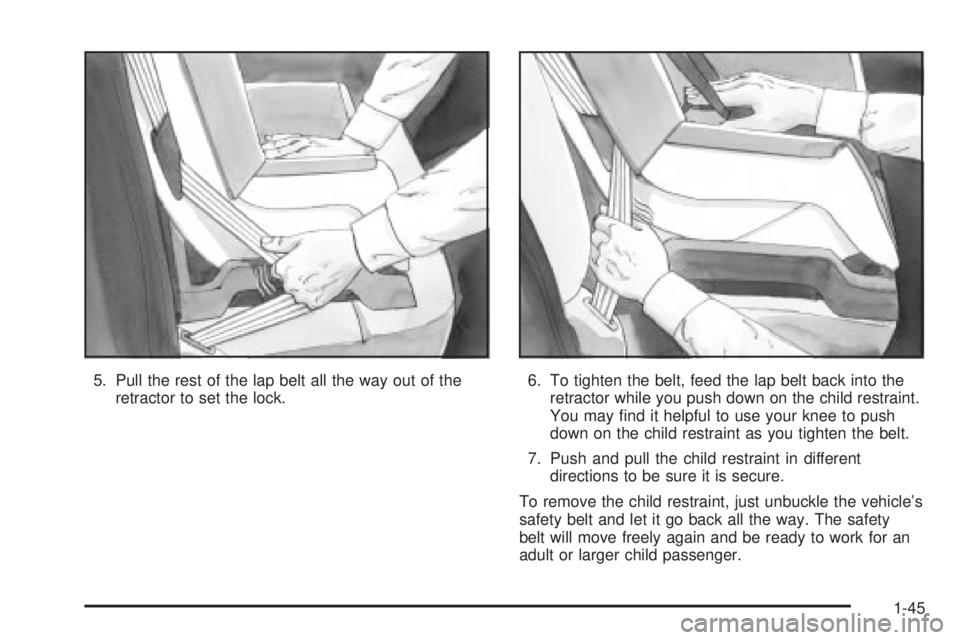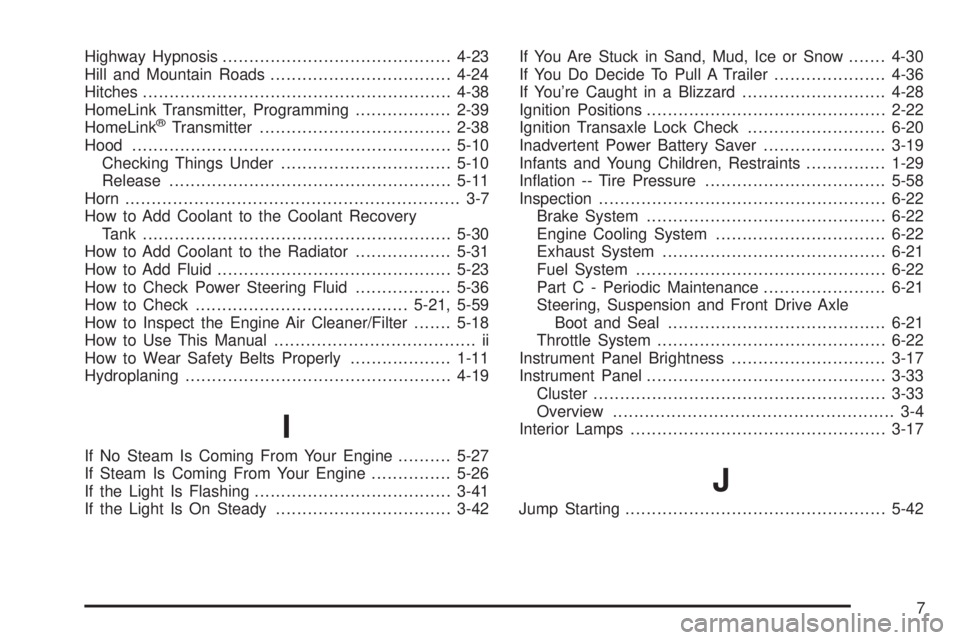child lock BUICK LESABRE 2003 Owner's Manual
[x] Cancel search | Manufacturer: BUICK, Model Year: 2003, Model line: LESABRE, Model: BUICK LESABRE 2003Pages: 380, PDF Size: 2.75 MB
Page 1 of 380

Seats and Restraint Systems........................... 1-1
Front Seats
............................................... 1-2
Safety Belts
.............................................. 1-6
Child Restraints
.......................................1-27
Air Bag Systems
......................................1-46
Restraint System Check
............................1-54
Features and Controls..................................... 2-1
Keys
........................................................ 2-3
Doors and Locks
....................................... 2-9
Windows
.................................................2-16
Theft-Deterrent Systems
............................2-18
Starting and Operating Your Vehicle
...........2-21
Mirrors
....................................................2-33
OnStar
žSystem
......................................2-37
HomeLinkžTransmitter
.............................2-38
Storage Areas
.........................................2-42
Sunroof
..................................................2-43
Vehicle Personalization
.............................2-44
Instrument Panel............................................. 3-1
Instrument Panel Overview
.......................... 3-4
Climate Controls
......................................3-24
Warning Lights, Gages and Indicators
.........3-32
Driver Information Center (DIC)
..................3-45
Audio System(s)
.......................................3-55Driving Your Vehicle....................................... 4-1
Your Driving, the Road, and Your Vehicle
..... 4-2
Towing
...................................................4-31
Service and Appearance Care.......................... 5-1
Service
..................................................... 5-3
Fuel
......................................................... 5-4
Checking Things Under the Hood
...............5-10
Headlamp Aiming
.....................................5-47
Bulb Replacement
....................................5-52
Windshield Wiper Blade Replacement
.........5-57
Tires
......................................................5-58
Appearance Care
.....................................5-77
Vehicle Identi®cation
.................................5-85
Electrical System
......................................5-85
Capacities and Speci®cations
.....................5-93
Normal Maintenance Replacement Parts
......5-94
Maintenance Schedule..................................... 6-1
Maintenance Schedule
................................ 6-2
Customer Assistance Information.................... 7-1
Customer Assistance Information
.................. 7-2
Reporting Safety Defects
............................ 7-9
Index.................................................................1
2003 Buick LeSabre Owner ManualM
Page 25 of 380

The best way to protect the fetus is to protect the
mother. When a safety belt is worn properly, it's more
likely that the fetus won't be hurt in a crash. For
pregnant women, as for anyone, the key to making
safety belts effective is wearing them properly.
Right Front Passenger Position
To learn how to wear the right front passenger's safety
belt properly, seeDriver Position on page 1-12.
The right front passenger's safety belt works the same
way as the driver's safety belt ± except for one thing.
If you ever pull the lap portion of the belt out all the way,
you will engage the child restraint locking feature. If
this happens, just let the belt go back all the way and
start again.
If your vehicle has a center passenger position, be sure
to use the correct buckle when buckling your
lap-shoulder belt. If you ®nd that the latch plate will not
go fully into the buckle, see if you are using the
buckle for the center passenger position.
Center Front Passenger Position
Lap Belt
If your vehicle has a front bench seat, someone can sit
in the center position.
1-19
Page 51 of 380

5. Pull the rest of the lap belt all the way out of the
retractor to set the lock.6. To tighten the belt, feed the lap belt back into the
retractor while you push down on the child restraint.
You may ®nd it helpful to use your knee to push
down on the child restraint as you tighten the belt.
7. Push and pull the child restraint in different
directions to be sure it is secure.
To remove the child restraint, just unbuckle the vehicle's
safety belt and let it go back all the way. The safety
belt will move freely again and be ready to work for an
adult or larger child passenger.
1-45
Page 71 of 380

To replace the battery, do the following:
1. Insert a coin, or similar object, into the notch near
the key ring. Turn it counterclockwise to separate
the two halves of the transmitter.
2. Once the transmitter is separated, use a pencil
eraser to remove the old battery. Do not use a
metal object.
3. Remove and replace the battery as the instructions
inside the cover indicate. Use one Duracell
ž
battery, type DL±2032, or a similar type.
4. Snap the transmitter back together tightly to be sure
no moisture can enter.
5. Check the operation of the transmitter.
Doors and Locks
Door Locks
{CAUTION:
Unlocked doors can be dangerous.
·Passengers Ð especially children Ð can
easily open the doors and fall out of a
moving vehicle. When a door is locked, the
handle will not open it. You increase the
chance of being thrown out of the vehicle
in a crash if the doors are not locked. So,
wear safety belts properly and lock the
doors whenever you drive.
·Young children who get into unlocked
vehicles may be unable to get out. A child
can be overcome by extreme heat and can
suffer permanent injuries or even death
from heat stroke. Always lock your vehicle
whenever you leave it.
·Outsiders can easily enter through an
unlocked door when you slow down or
stop your vehicle. Locking your doors can
help prevent this from happening.
2-9
Page 75 of 380

Rear Door Security Locks
Your vehicle is equipped
with rear door security
locks that prevent
passengers from opening
the rear doors of your
vehicle from the inside.
To use one of these locks, do the following:
1. Open the rear door you want to lock.
2. Move the lever located on the inside door edge, all
the way to the lock symbol.
3. Close the door.
4. Do the same thing to the other rear door lock.
The rear doors of your vehicle cannot be opened from
the inside when this feature is in use.
To open a rear door when the security lock is on, do the
following:
1. Unlock the door.
2. Open the door from the outside.If you don't cancel the security lock feature, adults or
older children who ride in the rear seat won't be able to
open the rear door from the inside. You should let
adults and older children know how these security locks
work, and how to cancel the locks.
To cancel the rear door lock, do the following:
1. Unlock and open the door from the outside.
2. Move the lever all the way to the unlock symbol.
3. Do the same for the other rear door.
The rear door locks will now work normally.
Lockout Protection
The power door locks will not work if the key is in the
ignition and a door is open. You can override this feature
by holding the driver's side power door lock switch for
more than three seconds.
Leaving Your Vehicle
If you are leaving the vehicle, take your keys, open your
door and set the locks from the inside. Then get out and
close the door. Or, press the lock button on the remote
keyless entry transmitter after shutting the doors.
If your vehicle has a theft-deterrent system, see
Content
Theft-Deterrent on page 2-18.
2-13
Page 202 of 380

Steering in Emergencies
There are times when steering can be more effective
than braking. For example, you come over a hill and ®nd
a truck stopped in your lane, or a car suddenly pulls
out from nowhere, or a child darts out from between
parked cars and stops right in front of you. You
can avoid these problems by braking Ð if you can stop
in time. But sometimes you can't; there isn't room.
That's the time for evasive action Ð steering around the
problem.
Your vehicle can perform very well in emergencies like
these. First apply your brakes.
See
Braking on page 4-6. It is better to remove as much
speed as you can from a possible collision. Then
steer around the problem, to the left or right depending
on the space available.An emergency like this requires close attention and a
quick decision. If you are holding the steering wheel at
the recommended 9 and 3 o'clock positions, you
can turn it a full 180 degrees very quickly without
removing either hand. But you have to act fast, steer
quickly, and just as quickly straighten the wheel
once you have avoided the object.
The fact that such emergency situations are always
possible is a good reason to practice defensive driving
at all times and wear safety belts properly.
4-12
Page 371 of 380

Highway Hypnosis...........................................4-23
Hill and Mountain Roads..................................4-24
Hitches..........................................................4-38
HomeLink Transmitter, Programming..................2-39
HomeLink
žTransmitter....................................2-38
Hood............................................................5-10
Checking Things Under................................5-10
Release.....................................................5-11
Horn............................................................... 3-7
How to Add Coolant to the Coolant Recovery
Tank ..........................................................5-30
How to Add Coolant to the Radiator..................5-31
How to Add Fluid............................................5-23
How to Check Power Steering Fluid..................5-36
How to Check........................................5-21, 5-59
How to Inspect the Engine Air Cleaner/Filter.......5-18
How to Use This Manual...................................... ii
How to Wear Safety Belts Properly...................1-11
Hydroplaning..................................................4-19
I
If No Steam Is Coming From Your Engine..........5-27
If Steam Is Coming From Your Engine...............5-26
If the Light Is Flashing.....................................3-41
If the Light Is On Steady.................................3-42If You Are Stuck in Sand, Mud, Ice or Snow.......4-30
If You Do Decide To Pull A Trailer.....................4-36
If You're Caught in a Blizzard...........................4-28
Ignition Positions.............................................2-22
Ignition Transaxle Lock Check..........................6-20
Inadvertent Power Battery Saver.......................3-19
Infants and Young Children, Restraints...............1-29
In¯ation -- Tire Pressure..................................5-58
Inspection......................................................6-22
Brake System.............................................6-22
Engine Cooling System................................6-22
Exhaust System..........................................6-21
Fuel System...............................................6-22
Part C - Periodic Maintenance.......................6-21
Steering, Suspension and Front Drive Axle
Boot and Seal.........................................6-21
Throttle System...........................................6-22
Instrument Panel Brightness.............................3-17
Instrument Panel.............................................3-33
Cluster.......................................................3-33
Overview..................................................... 3-4
Interior Lamps................................................3-17
J
Jump Starting.................................................5-42
7
Page 372 of 380

K
Key Lock Cylinders Service..............................6-18
Key Reminder Warning....................................2-23
Keyless Entry System....................................... 2-5
Keys............................................................... 2-3
L
Lamps...........................................................3-14
Exterior......................................................3-14
Interior.......................................................3-17
Language Selection.........................................3-54
Lap Belt........................................................1-19
Lap-Shoulder Belt...................................1-12, 1-21
LATCH System...............................................1-38
Child Restraints...........................................1-38
Securing a Child Restraint Designed for the
LATCH System........................................1-40
Leaving Your Vehicle With the Engine
Running.....................................................2-29
Leaving Your Vehicle.......................................2-13
Lighted Visor Vanity Mirror...............................2-17
Light.............................................................3-36
Air Bag Readiness.......................................3-36
Anti-Lock Brake System Warning...................3-38
Battery Warning..........................................3-37
Brake System Warning.................................3-37Light (cont.)
Cruise Control.............................................3-44
Malfunction Indicator....................................3-40
Oil Pressure...............................................3-43
Safety Belt Reminder...................................3-36
Security.....................................................3-44
Service Vehicle Soon...................................3-44
TCS Warning Light......................................3-39
Traction Control System (TCS) Warning..........3-39
Loading Your Vehicle.......................................4-33
Lockout Protection..........................................2-13
Locks............................................................2-10
Central Door Unlocking System.....................2-10
Delayed Locking..........................................2-11
Door........................................................... 2-9
Leaving Your Vehicle....................................2-13
Lockout Protection.......................................2-13
Power Door................................................2-10
Programmable Automatic Door Locks.............2-11
Rear Door Security Locks.............................2-13
Long Trip/Highway De®nition.............................. 6-6
Long Trip/Highway Intervals............................... 6-6
Long Trip/Highway Scheduled Maintenance........6-13
Loss of Control...............................................4-15
Lumbar........................................................... 1-3
Manual Controls............................................ 1-3
Power Controls............................................. 1-3
8